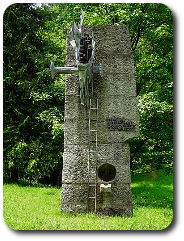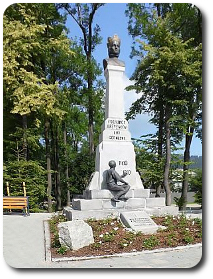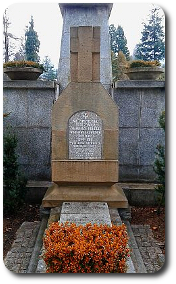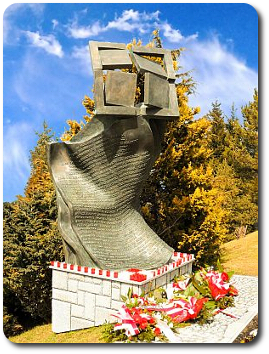WAR MEMORIALS
 Jozef Kuras, known as ‘The Eagle” (Orzel), was a lieutenant in the Polish Army during the German invasion of Poland and one of the leaders of the post-WWII anticommunist resistance who served during the September Campaign as part of the 2nd Polish Highland Battalion and, later, the Border Protection Corps. Born into a traditional highlander family, with strong patriotic values, Jozef became the leader of the Tatra Confederation partisan unit aged 26, as the war ensued. After escaping arrest by the Gestapo, who murdered his father, wife, two year old son, burned his house and sent two of Jozef’s brothers to a concentration camp, and following the dismantling of the Tatra Confederation, Kuras joined the units of the Polish Home Army under the pseudonym “Fire” (Ogien). Having fought the German forces, Kuras had the tough task of introducing his people into the local government and police in an attempt to retain at least local control over the Podhale region, with a Soviet invasion imminent. He did this by co-operating with the People’s Army, which was a puppet group set up to aid a pro-Soviet communist government in Poland. Towards the end of the war, having retreated back into the mountains, “Fire” set up a 700-man strong unit, refusing to come under the authority of any other organization. Units loyal to him were active in most of south central Poland. Kuras death came as a result of a gunfight during an ambush by the Secret Police in 1947 in Ostrowsko, in which his brother and another “Ogniowiec” tragically lost their lives. In the years following his demise, many communist propagandist writers have published works which branded Kuras as nothing more than a common, blood-thirsty bandit, claiming to base their accounts on his reconstructed, lost diaries, but these were clearly fabricated and more often than not, contained obviously over-sensationalised information. The many versions contradict themselves from one book to another in an attempt to discredit Kuras. In 2006, former president Lech Kaczynski unveiled a memorial in Zakopane, which salutes the resistance efforts of the “Ogniowcy” and Kuras, who after the fall of communism in Europe, was officially rehabilitated and recognised as a war hero who died in the name of Polish independence.
Jozef Kuras, known as ‘The Eagle” (Orzel), was a lieutenant in the Polish Army during the German invasion of Poland and one of the leaders of the post-WWII anticommunist resistance who served during the September Campaign as part of the 2nd Polish Highland Battalion and, later, the Border Protection Corps. Born into a traditional highlander family, with strong patriotic values, Jozef became the leader of the Tatra Confederation partisan unit aged 26, as the war ensued. After escaping arrest by the Gestapo, who murdered his father, wife, two year old son, burned his house and sent two of Jozef’s brothers to a concentration camp, and following the dismantling of the Tatra Confederation, Kuras joined the units of the Polish Home Army under the pseudonym “Fire” (Ogien). Having fought the German forces, Kuras had the tough task of introducing his people into the local government and police in an attempt to retain at least local control over the Podhale region, with a Soviet invasion imminent. He did this by co-operating with the People’s Army, which was a puppet group set up to aid a pro-Soviet communist government in Poland. Towards the end of the war, having retreated back into the mountains, “Fire” set up a 700-man strong unit, refusing to come under the authority of any other organization. Units loyal to him were active in most of south central Poland. Kuras death came as a result of a gunfight during an ambush by the Secret Police in 1947 in Ostrowsko, in which his brother and another “Ogniowiec” tragically lost their lives. In the years following his demise, many communist propagandist writers have published works which branded Kuras as nothing more than a common, blood-thirsty bandit, claiming to base their accounts on his reconstructed, lost diaries, but these were clearly fabricated and more often than not, contained obviously over-sensationalised information. The many versions contradict themselves from one book to another in an attempt to discredit Kuras. In 2006, former president Lech Kaczynski unveiled a memorial in Zakopane, which salutes the resistance efforts of the “Ogniowcy” and Kuras, who after the fall of communism in Europe, was officially rehabilitated and recognised as a war hero who died in the name of Polish independence.
 The monument “Prometeusz Rozstrzelany” (Prometheus Executed), is dedicated to the memory of 20 Polish men shot on the Wielka Kuznicka Glade by the German occupants on May 30, 1944. It was raised in 1964 by the artist Wladyslaw Hasior, one of the leading Polish contemporary sculptors connected with the Podhale region. Next to the statue is a wooden cross commemorating those gunned down and a plaque with an inscription which reads “Here died those, who reached the honorable title of defenders of the Fatherland – May 30, 1944”. The memorial is located on the Aleje Przewodnikow Tatrzanskich leading to Kuznice and a stream flows through the monument, making it a part of the landscape. Next to the statue, is a plaque which reads “Victims of Nazi crimes – people of Zakopane”.
The monument “Prometeusz Rozstrzelany” (Prometheus Executed), is dedicated to the memory of 20 Polish men shot on the Wielka Kuznicka Glade by the German occupants on May 30, 1944. It was raised in 1964 by the artist Wladyslaw Hasior, one of the leading Polish contemporary sculptors connected with the Podhale region. Next to the statue is a wooden cross commemorating those gunned down and a plaque with an inscription which reads “Here died those, who reached the honorable title of defenders of the Fatherland – May 30, 1944”. The memorial is located on the Aleje Przewodnikow Tatrzanskich leading to Kuznice and a stream flows through the monument, making it a part of the landscape. Next to the statue, is a plaque which reads “Victims of Nazi crimes – people of Zakopane”.
 The Zakopane Grunwald Monument is a granite column perched on a high stepped plinth. At the top, cast in bronze, is the bust of Polish King Wladyslaw Jagiello. At the base of the column are the words “Conquerors of the Teutonic Knights, highland people. 1410-1910 “. On the steps of the plinth is a bronze figure of a young mountaineer looking up at Jagiello. The Grunwald memorial was created to celebrate the 500th anniversary of the Battle of Grunwald and was unveiled on 20 August 1911 in Zakopane Market (today the Independence Square). In 1925, at the foot of the monument, an anonymous donor placed a plaque commemorating the Unknown Soldier. During the interwar period, many patriotic celebrations took place around the statue. During World War II, it was dismantled and the parts stored in Zakopane peoples’ homes. The monument was again erected on June 29, 1948 in the City Park. In 2012, the monument was transported back to its original place at the square and three time capsules were set into the concrete foundations; two which were discovered dating back to the restoration works in 1910 and 1948 and one contemporary. The capsule, dated August 23, 1911, contained the monument foundation act, which described its history of existence.
The Zakopane Grunwald Monument is a granite column perched on a high stepped plinth. At the top, cast in bronze, is the bust of Polish King Wladyslaw Jagiello. At the base of the column are the words “Conquerors of the Teutonic Knights, highland people. 1410-1910 “. On the steps of the plinth is a bronze figure of a young mountaineer looking up at Jagiello. The Grunwald memorial was created to celebrate the 500th anniversary of the Battle of Grunwald and was unveiled on 20 August 1911 in Zakopane Market (today the Independence Square). In 1925, at the foot of the monument, an anonymous donor placed a plaque commemorating the Unknown Soldier. During the interwar period, many patriotic celebrations took place around the statue. During World War II, it was dismantled and the parts stored in Zakopane peoples’ homes. The monument was again erected on June 29, 1948 in the City Park. In 2012, the monument was transported back to its original place at the square and three time capsules were set into the concrete foundations; two which were discovered dating back to the restoration works in 1910 and 1948 and one contemporary. The capsule, dated August 23, 1911, contained the monument foundation act, which described its history of existence.
 The Legionnaire’s Memorial was erected in 1927 in the Legionnaire’s Quarter of the New Cemetery in Zakopane on Ulica Nowotarska, along with other monuments dedicated to the combatants who gave their life for freedom during the First and Second World Wars. Annual Independence Day ceremonies are held at the site where the memories of the brave men are honoured. Among them, General Kazimierz Sosnowski who in 1925 initiated the adoption of the first international instrument addressing Biological weapons of Mass Destruction – the Geneva Protocol for the Prohibition of Poisonous Gases and Bacteriological Methods of Warfare, Marian Januszajtis, last commander of the 1st Brigade of Polish Legions who perished in Great Britain before his body was transported back to Zakopane, as well as Mieczyslaw Boruta-Spiechowicz, who was the September Campaign General during the Nazi invasion of Poland in 1939. Next to the Legionnaire’s statue is a large boulder, with a plaque which bears the names of those fallen with the inscription “Freedom and Independence was their aim in life. They served in the legions and rest here forever”.
The Legionnaire’s Memorial was erected in 1927 in the Legionnaire’s Quarter of the New Cemetery in Zakopane on Ulica Nowotarska, along with other monuments dedicated to the combatants who gave their life for freedom during the First and Second World Wars. Annual Independence Day ceremonies are held at the site where the memories of the brave men are honoured. Among them, General Kazimierz Sosnowski who in 1925 initiated the adoption of the first international instrument addressing Biological weapons of Mass Destruction – the Geneva Protocol for the Prohibition of Poisonous Gases and Bacteriological Methods of Warfare, Marian Januszajtis, last commander of the 1st Brigade of Polish Legions who perished in Great Britain before his body was transported back to Zakopane, as well as Mieczyslaw Boruta-Spiechowicz, who was the September Campaign General during the Nazi invasion of Poland in 1939. Next to the Legionnaire’s statue is a large boulder, with a plaque which bears the names of those fallen with the inscription “Freedom and Independence was their aim in life. They served in the legions and rest here forever”.
 Unveiled on April 22, 2012 at the church in Olcza, a district of Zakopane, this monument is dedicated to the 96 victims of the plane crash in Smolensk on the 10th of April 2010. Among the victims were the President of the Polish Republic Lech Kaczynski and his wife, the last exiled president of the Polish Republic Ryszard Kaczorowski, Deputy Marshals of the Parliament and the Senate along with other parliamentarians, the commanders of all of the Polish Armed Forces, employees of the Office of the President, heads of state institutions, the clergy, representatives of ministries, veterans’ and social organizations, and accompanying persons who were the Polish delegation travelling to the ceremony commemorating the 70th anniversary of the crimes committed on several thousand Polish officers captured by the army of the Soviet Union during the war in 1939, known as the Katyn Massacre. Nobody aboard the place survived the crash. Despite the passage of time, there have been no efforts to explain the circumstances which led to the complete destruction of the aircraft and the death of the entire political and military elite of Polish Nation. The Polish Government has still not received the wreckage or the original “black boxes”. A nine-foot bronze statue by Karol Badyna depicts the Polish Air Force checkerboard arranged into a cross. Below this symbol are the names of all 96 victims of the plane crash.
Unveiled on April 22, 2012 at the church in Olcza, a district of Zakopane, this monument is dedicated to the 96 victims of the plane crash in Smolensk on the 10th of April 2010. Among the victims were the President of the Polish Republic Lech Kaczynski and his wife, the last exiled president of the Polish Republic Ryszard Kaczorowski, Deputy Marshals of the Parliament and the Senate along with other parliamentarians, the commanders of all of the Polish Armed Forces, employees of the Office of the President, heads of state institutions, the clergy, representatives of ministries, veterans’ and social organizations, and accompanying persons who were the Polish delegation travelling to the ceremony commemorating the 70th anniversary of the crimes committed on several thousand Polish officers captured by the army of the Soviet Union during the war in 1939, known as the Katyn Massacre. Nobody aboard the place survived the crash. Despite the passage of time, there have been no efforts to explain the circumstances which led to the complete destruction of the aircraft and the death of the entire political and military elite of Polish Nation. The Polish Government has still not received the wreckage or the original “black boxes”. A nine-foot bronze statue by Karol Badyna depicts the Polish Air Force checkerboard arranged into a cross. Below this symbol are the names of all 96 victims of the plane crash.





